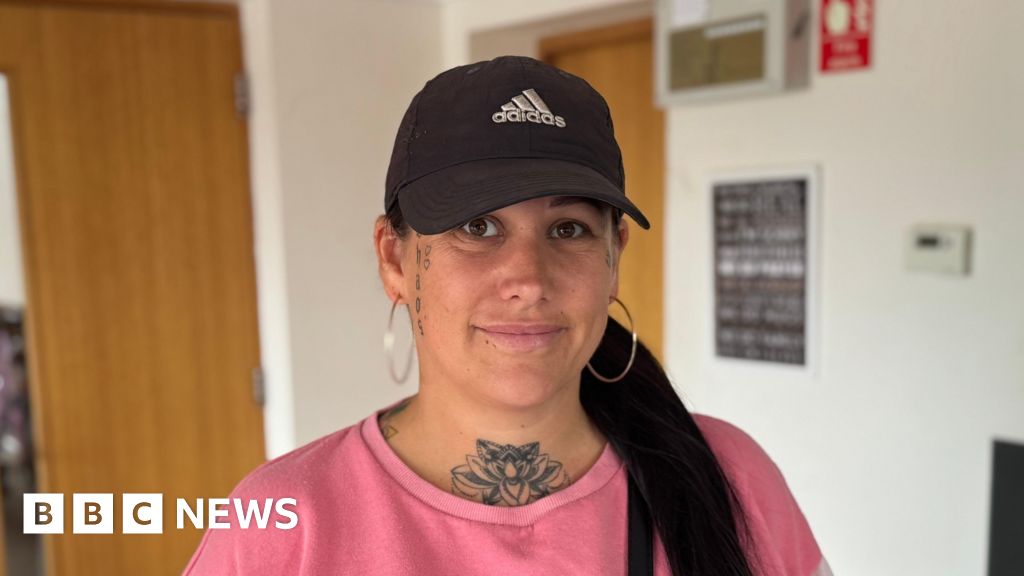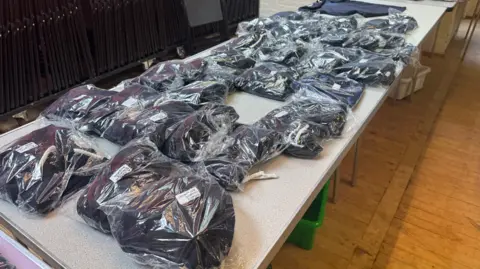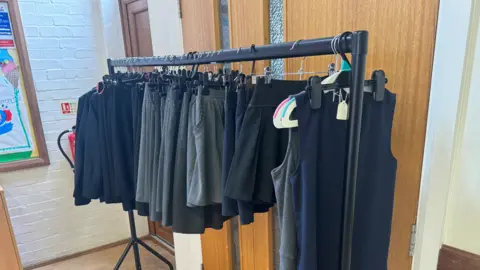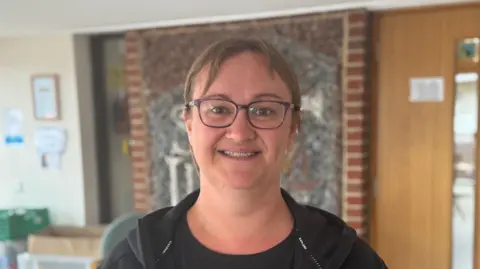Business
Free school uniform bank in Suffolk ‘vital’ say parents

BBC News, Suffolk
 George King/BBC
George King/BBCFor parents across Suffolk and further afield, buying school uniforms can prove pricey – setting them back hundreds of pounds per child.
Add in a recent increase in inflation, and the cost of kitting out the kids has become increasingly unaffordable for some families.
Some parents use school uniform banks where they can pick up everything from blazers, trousers and ties to clean underwear and shoes for free.
It is a service that can make a huge difference – but, as some parents at a uniform bank in Beccles have been telling us, it is a service that should perhaps not be needed at all.
‘It’s a real struggle’
“They shouldn’t have to be a thing, absolutely not, but they are a godsend and a blessing and they are just brilliant and really useful,” said 40-year-old Becky Mather.
“I have two teenage boys who grow very quickly, so you have to renew their stuff every year and you are looking at £100 per child at least.
“If they want the kids to wear a uniform they should issue a set of uniforms per child and then you just have to replace it if they break it, or make them more affordable.
“I am living on benefits at the moment and you just cannot afford uniform from your regular money – not if you want to eat at the same time. It’s a real struggle.”
 George King/BBC
George King/BBCUniform banks work in a similar way to foodbanks, in that they give people-in-need the opportunity to pick up essentials at no cost.
The latest data from the Department for Education (DfE) shows the average cost of a full uniform and PE kit for secondary school is £442.
Primary school parents can expect to fork out £343.
 George King/BBC
George King/BBCIn Beccles at the St Luke’s Church Centre, for example, Natalie Hull, 37, came away with a summer dress, a school skirt, a new tie, shirts, two polo shirts and new underwear.
“Somewhere like this is absolutely brilliant and it really helps out, because it is just a non-stop expense,” said the mother-of-two.
“I don’t know who is to blame – it’s just the economy, the uniforms being overpriced and the cost of living has gone up.
“We make cut-backs on trips and we haven’t been on a holiday abroad for years because we just cannot afford it.
“Nine times out of 10 I will get a second-hand uniform because new it is just extortionate.”
 George King/BBC
George King/BBCEarlier this year the government told schools that the number of compulsory branded items that they would be able to make parents purchase would be reduced.
It said seven in 10 secondary schools and 35% of primary schools in England could request three branded items, and a branded tie for secondary students.
The new rule was part of the Children’s Wellbeing and Schools Bill, which still has several parliamentary stages to go through before becoming law.
 George King/BBC
George King/BBC George King/BBC
George King/BBC“All the branded stuff is what costs the money – if you could have blazers and add your own patch then it would save an absolutely fortune,” said Laura Brockwell, 40.
“I work full-time but it’s still not enough to cover everyday living and then also uniform and shoes – is just extortionate.
“We’ve had to cut back on days out because that’s just expensive – if you have to choose between food and going out then you are going to choose food and uniforms.
“But that’s the way of living at the moment, unfortunately.”
 George King/BBC
George King/BBCExisting statutory guidance requires schools to consider the cost of their uniform so that it is not a deciding factor for parents when choosing schools.
The government claims parents will save around £50 per child through its new school uniform measures, which it plans to introduce in September 2026.
Fran Tuck, warden at St Luke’s Church Centre in Beccles, hoped it would make a difference.
“People are struggling and it seems such a shame they have to decide between buying uniform or having decent food,” she said.
“In an ideal world a uniform bank, like foodbanks and parish pantries, would not exist.
“But, unfortunately, people are living on the breadline and it is very difficult if you have three children and you are on a minimal income. Life is very hard.”
Business
Private sector data: Over 2 lakh private companies closed in 5 years; govt flags monitoring for suspicious cases – The Times of India

NEW DELHI: The government on Monday said that over the past five years, more than two lakh private companies have been closed in India.According to data provided by Minister of State for Corporate Affairs Harsh Malhotra in a written reply to the Lok Sabha, a total of 2,04,268 private companies were shut down between 2020-21 and 2024-25 due to amalgamation, conversion, dissolution or being struck off from official records under the Companies Act, 2013.Regarding the rehabilitation of employees from these closed companies, the minister said there is currently no proposal before the government, as reported by PTI. In the same period, 1,85,350 companies were officially removed from government records, including 8,648 entities struck off till July 16 this fiscal year. Companies can be removed from records if they are inactive for long periods or voluntarily after fulfilling regulatory requirements.On queries about shell companies and their potential use in money laundering, Malhotra highlighted that the term “shell company” is not defined under the Companies Act, 2013. However, he added that whenever suspicious instances are reported, they are shared with other government agencies such as the Enforcement Directorate and the Income Tax Department for monitoring.A major push to remove inactive companies took place in 2022-23, when 82,125 companies were struck off during a strike-off drive by the corporate affairs ministry.The minister also highlighted the government’s broader policy to simplify and rationalize the tax system. “It is the stated policy of the government to gradually phase out exemptions and deductions while rationalising tax rates to create a simple, transparent, and equitable tax regime,” he said. He added that several reforms have been undertaken to promote investment and ease of doing business, including substantial reductions in corporate tax rates for existing and new domestic companies.
Business
Pakistan’s Textile Exports Reach Historic High in FY2025-26 – SUCH TV

Pakistan’s textile exports surged to $6.4 billion during the first four months of the 2025-26 fiscal year, marking the highest trade volume for the sector in this period.
According to the Pakistan Bureau of Statistics (PBS), value-added textile sectors were key contributors to the growth.
Knitwear exports reached $1.9 billion, while ready-made garments contributed $1.4 billion.
Significant increases were observed across several commodities: cotton yarn exports rose 7.74% to $238.9 million, and raw cotton exports jumped 100%, reaching $2.6 million from zero exports the previous year.
Other notable gains included tents, canvas, and tarpaulins, up 32.34% to $53.48 million, while ready-made garments increased 5.11% to $1.43 billion.
Exports of made-up textile articles, excluding towels and bedwear, rose 4.17%, totaling $274.75 million.
The report also mentioned that the growth in textile exports is a result of improved global demand and stability in the value of the Pakistani rupee.
Business
Peel Hunt cheers ‘positive steps’ in Budget to boost London market and investing

UK investment bank Peel Hunt has given some support to under-pressure Chancellor Rachel Reeves over last week’s Budget as it said efforts to boost the London market and invest in UK companies were “positive steps”.
Peel Hunt welcomed moves announced in the Budget, such as the stamp duty exemption for shares bought in newly listed firms on the London market and changes to Isa investing.
It comes as Ms Reeves has been forced to defend herself against claims she misled voters by talking up the scale of the fiscal challenge in the run-up to last week’s Budget, in which she announced £26 billion worth of tax rises.
Peel Hunt said: “Following a prolonged period of pre-Budget speculation, businesses and investors now have greater clarity from which they can start to plan.
“The key measures were generally well received by markets, particularly the creation of additional headroom against the Chancellor’s fiscal rules.
“Initiatives such as a stamp duty holiday on initial public offerings (IPOs) and adjustments to the Isa framework are intended to support UK capital markets and encourage investment in British companies.
“These developments, alongside the Entrepreneurship in the UK paper published simultaneously, represent positive steps toward enhancing the UK’s attractiveness for growth businesses and long-term investors.”
Ms Reeves last week announced a three-year stamp duty holiday on shares bought in new UK flotations as part of a raft of measures to boost investment in UK shares.
She also unveiled a change to the individual savings account (Isa) limit that lowers the cash element to £12,000 with the remaining £8,000 now redirected into stocks and shares.
But the Chancellor also revealed an unexpected increase in dividend tax, rising by 2% for basic and higher rate taxpayers next year, which experts have warned “undermines the drive to increase investing in Britain”.
Peel Hunt said the London IPO market had begun to revive in the autumn, although listings activity remained low during its first half to the end of September.
Firms that have listed in London over recent months include The Beauty Tech Group, small business lender Shawbrook and tinned tuna firm Princes.
Peel Hunt added that deal activity had “continued at pace” throughout its first half, with 60 transactions announced across the market during that time and 10 active bids for FTSE 350 companies, as at the end of September.
Half-year results for Peel Hunt showed pre-tax profits jumped to £11.5 million in the six months to September 30, up from £1.2 million a year earlier, as revenues lifted 38.3%.
Peel Hunt said its workforce has been cut by nearly 10% since the end of March under an ongoing savings drive, with full-year underlying fixed costs down by around £5 million.
Steven Fine, chief executive of Peel Hunt, said: “The second half has started strongly, with the group continuing to play leading roles across both mergers and acquisitions and equity capital markets mandates.”
-

 Sports1 week ago
Sports1 week agoWATCH: Ronaldo scores spectacular bicycle kick
-

 Entertainment1 week ago
Entertainment1 week agoWelcome to Derry’ episode 5 delivers shocking twist
-

 Politics1 week ago
Politics1 week agoWashington and Kyiv Stress Any Peace Deal Must Fully Respect Ukraine’s Sovereignty
-

 Business1 week ago
Business1 week agoKey economic data and trends that will shape Rachel Reeves’ Budget
-

 Politics1 week ago
Politics1 week ago53,000 Sikhs vote in Ottawa Khalistan Referendum amid Carney-Modi trade talks scrutiny
-

 Tech6 days ago
Tech6 days agoWake Up—the Best Black Friday Mattress Sales Are Here
-

 Fashion1 week ago
Fashion1 week agoCanada’s Lululemon unveils team Canada kit for Milano Cortina 2026
-

 Tech1 day ago
Tech1 day agoGet Your Steps In From Your Home Office With This Walking Pad—On Sale This Week







